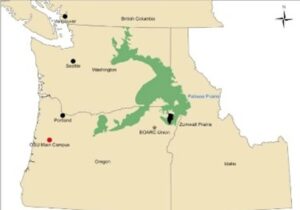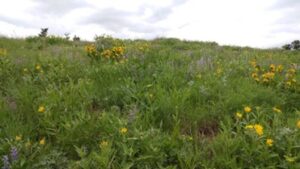It is a wondrous site, this grand inland sea, extending from horizon to horizon as the gentle breeze creates apparent waves that drift across the landscape. But we are not speaking of a sea of water but rather of grain. The grandeur has been captured in the words of a well-known song –
“Oh beautiful, for spacious skies
for amber waves of grain
for purple mountain majesties
above the fruited plain”
The words referring to “the amber waves of grain” depict the expansive grain fields of Kansas. Here the reference is to the Palouse grasslands that historically covered 19,000 square miles in Eastern Washington extending into Idaho and northeastern Oregon. Today, most of this area supports wheat farms as far as the eye can see. It is dry land farming with an average rainfall of 10 to 20 inches. That is not sufficient to farm the drier areas on an annual basis. The farmers “fallow” the land every other year to store sufficient water from the winter precipitation to allow a crop the next year.
The soil of the Palouse is known as loess with fine silt-sized particles derived from the action of advancing continental glaciers grinding up the bedrock. The fine dust-sized particles were wind deposited farther south building up soil in some places 50 or more feet deep. As the farms lay fallow, strong winds often create dust storms carrying the precious soil away. Times of zero visibility exist creating dangerous driving conditions.
 Historically the Palouse was native prairie – the home of a myriad of creatures adapted to this unique ecosystem – large grazing mammals, reptiles, birds, soil dwellers, and insects associated with the highly diverse plant species. The insects include important native pollinators. It is hard to understand what the area looked like historically when one drives through the current wheat fields! Today less than 1% of the original prairie remains. Efforts by the Nature Conservancy to preserve the most significant remnants have resulted in what is called the Zumwalt Prairie encompassing approximately 51 square miles. The area is a mix of private ranches and publicly owned land. About half of it is managed for cattle grazing. In April 2013 the National Park Service designated 4,400 acres as a National Natural Landmark – the Zumwalt Prairie Preserve. You might consider a visit to this unique and important National Landmark.
Historically the Palouse was native prairie – the home of a myriad of creatures adapted to this unique ecosystem – large grazing mammals, reptiles, birds, soil dwellers, and insects associated with the highly diverse plant species. The insects include important native pollinators. It is hard to understand what the area looked like historically when one drives through the current wheat fields! Today less than 1% of the original prairie remains. Efforts by the Nature Conservancy to preserve the most significant remnants have resulted in what is called the Zumwalt Prairie encompassing approximately 51 square miles. The area is a mix of private ranches and publicly owned land. About half of it is managed for cattle grazing. In April 2013 the National Park Service designated 4,400 acres as a National Natural Landmark – the Zumwalt Prairie Preserve. You might consider a visit to this unique and important National Landmark.
 There are many “woes” in the Bible. The one I am thinking of is found in Isaiah 5:8. The New International Version translates it as follows: “Woe to you who add house to house and join field to field till no space is left and you live alone in the land”. What was the context and what did it mean to Isaiah’s audience? According to Robert Alter, world renowned Jewish Old Testament scholar, Isaiah is admonishing the rich Israelites for buying up all the land resulting in the poor having no place to live. But what of the other creatures? We have previously considered the Biblical mandate to care for creation as stewards — as an act of reciprocity. The non-human creation provides for us as we in turn nurture Creation’s fruitfulness. The Palouse has lost more than 99% of its functional ecosystem – converted to wheat fields to exclusively meet human “needs.” What about the other species who depend on us? Who speaks for the non-human creatures? Are you their voice?
There are many “woes” in the Bible. The one I am thinking of is found in Isaiah 5:8. The New International Version translates it as follows: “Woe to you who add house to house and join field to field till no space is left and you live alone in the land”. What was the context and what did it mean to Isaiah’s audience? According to Robert Alter, world renowned Jewish Old Testament scholar, Isaiah is admonishing the rich Israelites for buying up all the land resulting in the poor having no place to live. But what of the other creatures? We have previously considered the Biblical mandate to care for creation as stewards — as an act of reciprocity. The non-human creation provides for us as we in turn nurture Creation’s fruitfulness. The Palouse has lost more than 99% of its functional ecosystem – converted to wheat fields to exclusively meet human “needs.” What about the other species who depend on us? Who speaks for the non-human creatures? Are you their voice?
Our Prayer: Lord, may we be responsible caretakers of your Creation in our daily choices. We ask you to give us eyes to see and ears to hear the groaning of creation that is described in Romans 8:22 -23 — and the will to respond in love. Amen.
Thanks for listening.
— Joe Sheldon
Direct comments to Joe Sheldon at [email protected]
If you would like to receive additional information on Creation care, notices of special events, Creation walks I lead, etc. please contact me at the above address and I will add you to my e-mail list. Your comments are welcome.


